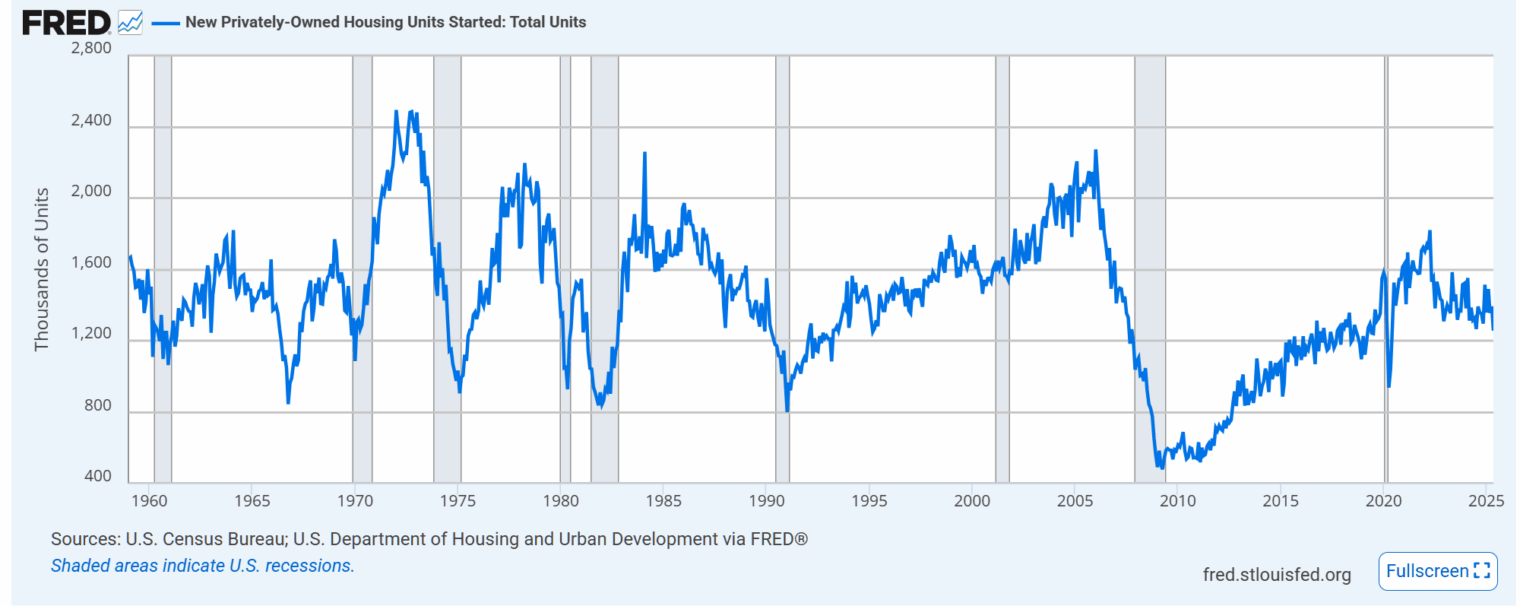Happy National Construction Appreciation Week to those who celebrate.
We’re supposedly building roughly the same number of new houses and apartments that we did in 1960 when the U.S. population was 180 million, i.e., roughly half of what it is now. St. Louis Fed:
During the intervening years we had an influx of about 80 million immigrants (Pew for 1965-2015 then add for the extra years before and after) and we are also home now to the children of those immigrants. How is it possible that we haven’t been building more houses in the aggregate?
One possible answer is that families are much larger today and, therefore, we have more people in the typical house or apartment. But 1960 was prior to the age of no-fault (unilateral) divorce. ChatGPT:
Another possible answer is that we have people living in tents, California-style. But Brookings says “Our calculations show that the U.S. housing market was short 4.9 million housing units in 2023 relative to mid-2000s”. I.e., if we assume a household size of 2, at most 10 million Americans and migrants are living in tents. (Note that this 10 million number is roughly comparable to the number of undocumented migrants who came across the border during the the Biden-Harris administration.)
A final possible answer is that we are living in shabby old houses. I asked ChatGPT:
Maybe this is good because it shows that we did such a great job building homes circa 1960-1980 that they’re not wearing out? ChatGPT says it is not good:
I can’t figure out how this happened. We are informed that migrants are skilled eager construction workers. Labor is 30-50 percent of the cost of building a single-family house. We are richer in migrants than at any time in U.S. history. Why wouldn’t we have at least the same ratio of housing starts to population size that we had in 1960 before we began to be enriched by migrants?
In fact, the New York Times says it is more or less impossible for us to have built any houses without immigrants: “How Would We Build Homes Without Immigrant Labor and Foreign Materials?” (April 1, 2025)
Related:
- “Yale Study Finds Twice as Many Undocumented Immigrants as Previous Estimates” (using 2016 data) reminds us that the above numbers on total population and immigrant population might be underestimates by roughly 10 million





> How is it possible that we haven’t been building more houses in the aggregate?
Housing starts are so expensive that builders create fewer, higher profit McMansions. I really wish they would go back towards functional vs. the latest pink granite countertop bling. That would require social engineering, and reversing the nature of real estate agents–a currently intractable problem. During the pandemic, many Millenials decided to reverse their position about urban living, and are flooding in to the suburbs–which isn’t helping.
After being layed off at Microsoft, my BIL is working on improving the housing stock of his city, kind of high quality flipping. More businesses like this, who find a way to make it profitable without shortcuts, would help a lot.
The auto blog poster still has yet to cover Jerry Greenfield finally quitting the Ben & Jerry business over selling ice cream to jews.
Phil, your thesis appears to be that there is a shortage of housing now vs. 1960, but Grok says that in 1960 there were 58.0m housing units and population of 180.7m and as of 2024 147.0m and 340.1m (excluding uncounted/illegals), respectively, so units per person has gone *up* from .32 to .43, right?
Confused: It makes sense that units per person has gone up because family size has gone down. But with units per person up while housing starts are at a low level we have the “we are living in shabby old houses” explanation from the original post.
Phil, the data totally refute your “we are living in shabby old houses” now vs. 1960: just ask Grok or think back to your childhood. No study or analysis would support the thesis that the U.S. housing stock now is “shabby” vs. 1960. A few examples:
1) 14% of housing units lacked indoor plumbing in 1960 (<.5% now)
2) 19% of homes lacked a full kitchen in 1960 (<1% now).
3) Density (people per unit) was .85 in 1960 and .45 now.
4) Heating systems were 15% coal/wood vs. <1% now.
5) Air conditioning penetration was 15% vs. 90% now.
And on and on…not even close.
Anon: I guess what you’re saying and the original post could both be true. The average age of a house has gone up from about 22 years in 1960 to about 44 years today, but a house built circa 1938 isn’t nearly as nice as a house built circa 1981.
Maybe all the desirable, practical locations have already been built up to capacity? And/or maybe “newcomers” are willing to accept a lower standard of living, by cramming 4 families into what used to be considered a single family house (zoning rules be damned)?